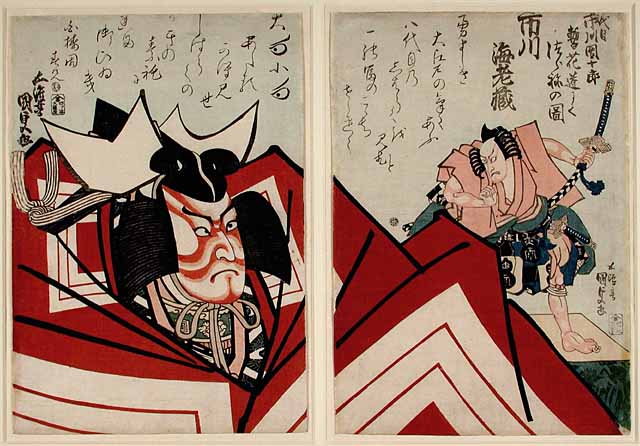
Ichikawa Danjuro VIII as Kamakura Gongoro in Shibaraku! (Stop Right There!) with Ichikawa Ebizo V (formerly Danjuro VII) in the background as the villain Narita Goro.
Kunisada 5
c.1836
Private collection
This diptych commemorates the debut of Danjuro VII’s eldest son in the central role of this play. The role is one of the great examples of the ‘rough-stuff’ style (aragoto) for which the Ichikawa line of actors was famous. Danjuro VIII is striking a defiant pose on the raised passageway (hanamichi) leading from the back of the theatre through the audience to the main stage, while his father, playing the role of the villain, looks on from the main stage.
This is the great moment when Narita Goro, on the point of executing the innocent Yoshitsuna and his fiance, is halted by the powerful voice of Gongoro coming from the rear of the theatre shouting ‘Shibaraku! Shibaraku!’ (‘Stop right there!’). The hero then strides onto the hanamichi wearing the most extravagant aragoto costume: a voluminous suo (‘plain sliding-door’) robe, with the Danjuro mon adorning square sleeves so wide that they have to be supported with splints. Laudatory poems fill the space above the figures. This impression, the only known surviving example of this diptych, has faded: the thick cord around Danjuro VIII’s neck was originally bright red, and the thin cord was purple.
Loan 499
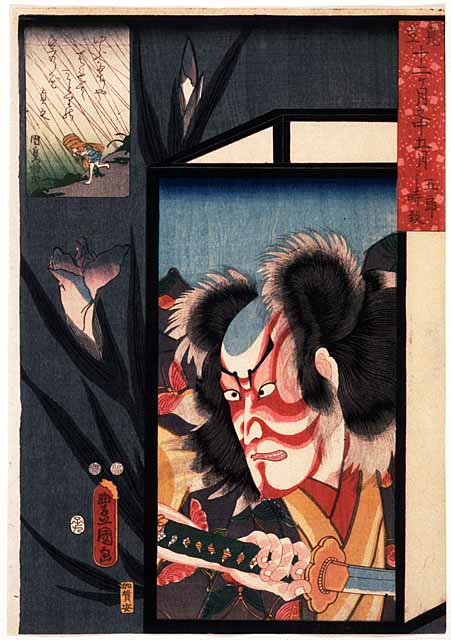
Gogatsu Goro Tokimune (Fifth Month: Goro Tokimune)
09/1852
Given by the Friends of the Fitzwilliam with the aid of the MGC Purchase Grant Fund and the National Art Collections Fund.
Portrait of Ichikawa Danjuro VIII as Soga no Goro, from the series Mitate juni-ka-getsu (Comparisons with the Twelve Months).
The portrait is depicted as though the face is painted on a lantern, and is accompanied by an inset designed by Kunisada II (1823-80) showing a figure running in a sudden evening shower. Plays telling of the revenge taken by the Soga no Goro and his brother Soga no Juro on their father’s murderer were traditionally performed at New Year, but there were also quick-change dance pieces (henge mono) devoted to single characters, which were performed at other times of year. One of these was Ame no Goro (‘Rainfall Goro’) or Tokimune first created in 1841 for a festival honouring the Soga brothers. Its story involves Goro’s visit to the pleasure quarters to visit his mistress during a rain-storm. He wears a richly-embroidered robe with the butterfly motif associated with the character, and the sort of red make-up (beni guma) and wild-haired wig typical of the aragoto (‘rough-stuff’) roles specially associated with the Ichikawa lineage of actors.
Each actor in this series is matched with a month; the connection in this print may be that the revenge in the Soga story took place in the fifth month. The iris is the symbol of the Fifth Month.
Collections Record: P.61-1999
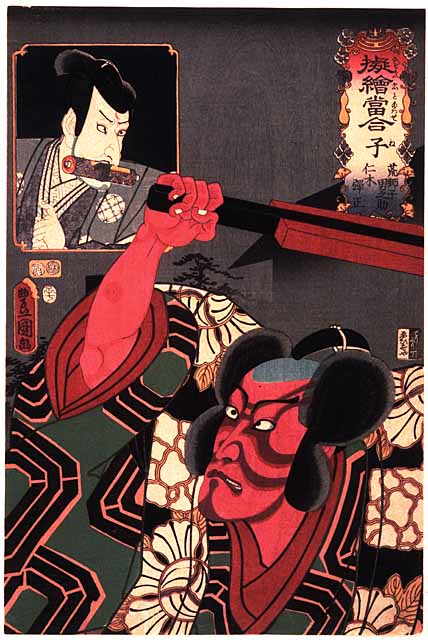
Arajishi Otokonosuke Nikki Danjo Ne (Arajishi Otokonosuke and Nikki Danjo: Rat)
10/1852
Given by the Friends of the Fitzwilliam with the aid of the MGC Purchase Grant Fund and the National Art Collections Fund.
Portrait of Ichikawa Danjuro VIII as Arajishi Otokonosuke with an inset portrait of Matsumoto Koshiro V as Nikki Danjo in Date kurabe Okuni Kabuki (A competition in ostentation: Okuni’s Kabuki), from the series Nazorae eto-awase (Allusions to the Zodiac Signs).
This series matches the roles played by actors to signs of the zodiac. In this print the reference to the zodiac sign for the rat is evident to those with a knowledge of the Yukashita (‘Under the floor of the Palace’) scene of the play. The evil samurai Nikki Danjo (shown in the inset) transformed himself into a giant rat and in this guise he snatches a precious scroll and runs away with it in his mouth to hide beneath the palace floorboards. In the ensuing scene under the floor, the loyal samurai Arajishi Otokonosuke (the main figure in the print) uses his iron fan to strike the rat on the forehead. The rat is then transformed into his true self, disappearing through a trap door out of which Nikki is seen to rise, with the scroll still held in his mouth and a crescent-shaped wound from the blow on his forehead. He floats into the air and disappears into a cloud in the upper reaches of the theatre, with Otokonosuke posturing in aragoto (‘rough-stuff’) style on the main stage below. These stage postions are reflected in the design of this print.
A print of the same scene was published four months earlier in a zodiac series designed by Kuniyoshi, illustrating the cast of a performance in 1851. Kunisada’s print depicts an imaginary perfromance with a ‘dream cast’, in which the current star Danjuro VIII appears with Koshiro V, who had died in 1838, some fourteen years before this print was published. Koshiro was the most famous Nikki in history (his 1818 performance opposite Danjuro VII in this scene was recorded in a diptych by Kunisada published in that year). Even today actors playing Nikki wear Koshiro’s crest and costume pattern, and they use make-up to recreate the large spot that Koshiro had above his left eyebrow.
Collections Record: P.66-1999
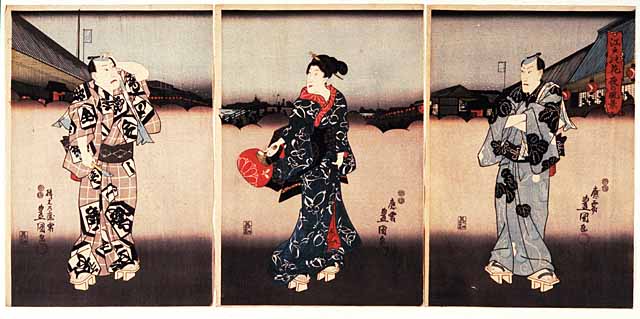
Edo no hana yoru no fukei (Flowers of Edo: A Night View)
c.1847-52
Given by the Friends of the Fitzwilliam with the aid of the MGC Purchase Grant Fund and the National Art Collections Fund.
A triptych showing three leading Edo (Tokyo) actors of the 1840s in summer kimono: Ichikawa Danjuro VIII (right), Bando Shuka I (centre) and NakamuraUtaemon IV (left).
Collections Record: P.57-1999
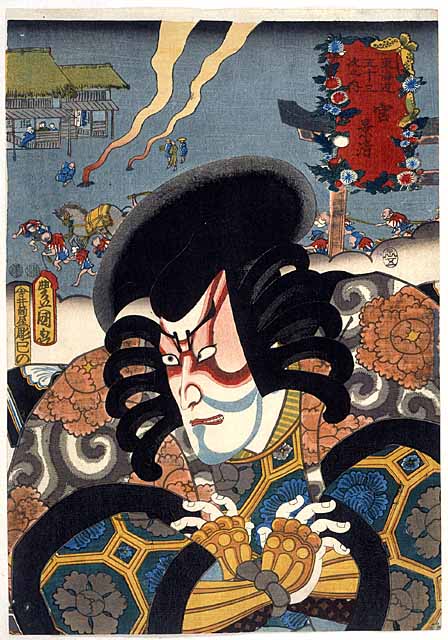
05/1852
Given by the Friends of the Fitzwilliam with the aid of the MGC Purchase Grant Fund and the National Art Collections Fund.
A portrait of Ichikawa Danjuro VIII as Kagekiyo, with a view of Miya on the Tokaido Highway in the background, from the series Tokaido gojusan tsugi no uchi (Fifty-three stations of the Tokaido Highway).
Akushichibyoe Kagekiyo, a leading Heike warrior in the Gempei wars, featured only briefly in the historical chronicle Heike Monogatari (Tale of the Heike) but assumed great prominence in legend and in numerous kabuki and puppet dramas known as Kagekiyo mono (Kagekiyo plays). One version was included by Danjuro VII in his selection of Eighteen Plays (Kabuki Juhachiban) specially associated with the Ichikawa lineage. The role called for the Ichikawa speciality of aragoto (‘rough-stuff’) acting, with a dotera (padded-dressing-gown) costume, huge bushy wig and red make-up (beni suji) with suji gama (‘line shadows’) and painted blue beard (han guma).
As with all the prints in this series (two of them included here), the landscape in the background is heavily indebted to a print in Hiroshige’s famous series of Tokaido views published 20 years earlier.
Collections Record: P.60-1999



